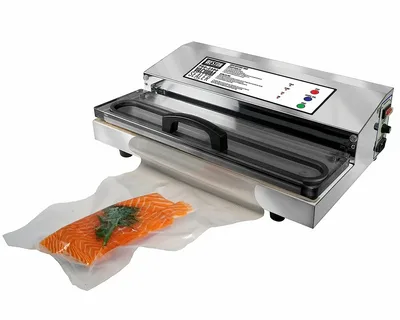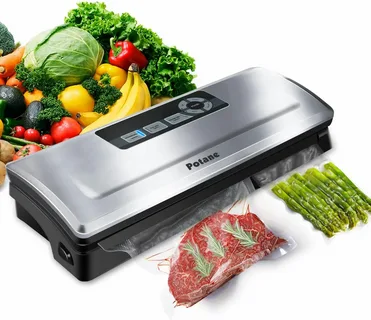Are you tired of throwing away spoilt food? Do you want to save money by reducing food waste? If so, investing in the best vacuum-sealer could be the solution for you. A vacuum-sealer is a handy kitchen appliance that helps extend the shelf life of your food by removing air and sealing it in a vacuum-sealed bag. In this guide, we will explore the benefits of using a vacuum-sealer, the key features to look for when choosing one, and some tips for the best vacuum sealer.
Enhancing Food Preservation and Shelf Life
A paramount advantage of utilising a vacuum-sealer is its capacity to significantly improve the preservation and prolong the longevity of your food items. This appliance operates by extracting air from the packaging, a process which crucially mitigates the rate of oxidation. Oxidation is a primary cause of food degradation, leading to spoilage and waste. As air is removed and the food is securely sealed within vacuum-sealed bags, the growth of bacteria and mould is substantially inhibited.
Consequently, your perishables, including fruits, vegetables, meats, and even dry goods, maintain their freshness for an extended period. This not only ensures that your food retains its nutritional value but also its taste, texture, and colour, thereby enhancing your overall culinary experience. The ability to preserve food effectively with a vacuum-sealer thus stands as a cornerstone in modern kitchen practices, aimed at sustainability and efficiency.
 Savings on Food Costs in the Long Run
Savings on Food Costs in the Long Run
Embracing a vacuum sealer can lead to considerable financial savings over time, an aspect not to be underestimated in today’s economic climate.
Investment in Food
The initial investment in a vacuum sealer paves the way for the bulk purchase of ingredients without the typical concern for rapid spoilage. This approach is particularly beneficial when encountering sales or bulk buying opportunities, enabling households to stock up on staples and favourites at a fraction of the cost.
Reduced Waste
Moreover, the reduction in food waste directly translates to a decrease in the frequency of purchasing perishables, thus conserving funds that would otherwise be spent on replacing spoiled goods. The extended shelf life provided by vacuum sealing means less frequent shopping trips and, as a result, a notable reduction in impulse buys, a common occurrence during routine grocery shopping.
Prepare & Store Meals
In the context of meal preparation, the vacuum sealer presents an opportunity to prepare and store meals in advance, further contributing to cost efficiency by allowing for the purchase and use of seasonal produce and meats when they are at their most affordable.
This strategy of vacuum sealing not only champions the cause of sustainability by reducing food waste but also aligns with a mindful budgeting approach, ensuring that every penny spent on groceries is utilised to its fullest potential.
A Boon for Meal Preppers and Home Cooks
For those who dedicate part of their week to meal preparation, incorporating a vacuum-sealer into the process can transform the efficiency and effectiveness of this task. The ability to portion and seal meals in advance eliminates the daily hassle of cooking, making it an invaluable tool for individuals with packed schedules. It ensures that the nutritional and taste quality of meals is preserved, mirroring the freshness of dishes made on the day.
Furthermore, it allows for a diverse menu throughout the week, as different types of meals—from vibrant vegetable sides to protein-packed mains—can be prepared, sealed, and stored without the risk of cross-contamination or flavour loss. The vacuum-sealer stands out as an indispensable ally in the kitchen, streamlining the meal prep process and elevating the quality of home-cooked meals, thereby redefining convenience and health for busy households.
The Role of a Food Vacuum Sealer in Sous Vide Cooking
For enthusiasts of the sous vide method, the food vacuum sealer emerges as an indispensable kitchen gadget. This culinary technique, beloved for delivering uniformly cooked meals with unparalleled flavour and texture, relies on the precise control of temperature and cooking duration. The pivotal role of a vacuum sealer in this process cannot be overstated.
By ensuring that food is meticulously sealed within vacuum-sealed bags, it eliminates the presence of air that could disrupt the cooking environment, guaranteeing that heat is distributed evenly across the food item. This not only enhances the efficiency of heat transfer but also prevents water from infiltrating the bag, a common challenge that can dilute flavours and affect the cooking outcome.
Moreover, the vacuum sealer’s contribution extends beyond just the practicalities of cooking. It aids in marinating the food more effectively, as the absence of air allows the marinade to penetrate deeper into the tissues of the food, enriching it with more robust flavours. For those who pursue the art of sous vide cooking, a vacuum sealer is not just a tool but a partner in crafting dishes that stand out for their texture, taste, and nutritional integrity. Its utility in creating the perfect sous vide experience exemplifies its importance in the modern culinary repertoire.
Key Features to Look For in a Vacuum-Sealer
Selecting the optimal vacuum-sealer for your culinary endeavours entails a careful examination of several pivotal characteristics. Firstly, prioritise finding a unit equipped with variable settings, which enable the sealing of diverse food types from delicate berries to hardier cuts of meat, without compromising their integrity. A potent vacuum pump is essential, offering robust air extraction capabilities to ensure that the food is preserved in an almost completely oxygen-free environment.
The quality of the sealing bar deserves special attention as well; a resilient and well-constructed sealing mechanism is crucial for creating an impervious seal that guarantees the longevity of your foodstuffs. Additionally, the inclusion of user-friendly features such as an integrated bag cutter and roll storage can substantially enhance the convenience and efficiency of your vacuum-sealing process, streamlining the preparation stage.
For those seeking the utmost in versatility, models that accommodate a wide array of bag sizes offer greater flexibility in managing different quantities of food. It’s also worth considering models that boast a moist food setting, catering to the sealing of marinated or naturally juicy foods without compromising the machine’s functionality. Keeping these factors in mind will guide you in identifying a vacuum-sealer that not only meets but exceeds your preservation needs, thereby becoming an indispensable asset in your kitchen repertoire.
Understanding the Different Types of Vacuum-Sealers
Navigating through the variety of vacuum-sealers on the market is crucial to finding one that aligns with your specific needs.
Handled Models
Handheld models are lauded for their portability and ease of use, ideal for those with limited storage space or occasional sealing tasks. These devices are typically battery-operated and work best for sealing small batches of food at a time.
External Vacuum Sealers
On the other hand, external vacuum-sealers, which are more commonly found in domestic kitchens, offer a balance of performance and convenience. They are designed to sit on the countertop and can handle a larger volume of sealing tasks with varying degrees of control over the sealing process.
Chamber Vacuum Sealers
For individuals or businesses requiring the highest level of efficiency and durability, chamber vacuum-sealers present the best option. These are predominantly used in commercial settings due to their capability to seal large quantities of food quickly and their versatility in handling a wide range of products, including liquids, without the need for pre-freezing. Each type of vacuum-sealer has its unique benefits, making it important to assess your usage frequency, the volume of food you plan to seal, and your kitchen space before making a decision.
Care and Maintenance Tips for a Vacuum Packing Machine
To prolong the life and effectiveness of your vacuum packing machine, adhering to regular care and maintenance routines is paramount. It is recommended to meticulously clean both the sealing bar and the gaskets after each use, ensuring that no remnants of food compromise the sealing effectiveness in future operations. Inspecting and promptly replacing any parts that show signs of wear or damage is crucial for maintaining the device’s optimal performance.
Furthermore, it is advisable to consult the manufacturer’s guidelines for specific maintenance advice tailored to your model. Keeping the exterior of the machine clean and free from debris not only contributes to its functional longevity but also maintains its hygiene standards. Regular checks and maintenance not only safeguard the appliance’s operational integrity but also support a consistently high standard of food preservation.
Tips for Optimal Vacuum-Sealing Results
For those keen to master the art of vacuum-sealing, a few strategic tips can significantly elevate the quality of your outcomes. Firstly, ensure that there is a sufficient margin—ideally a few centimetres—between the food and the seal of the bag. This precaution allows the vacuum-sealer to function effectively, creating a robust seal that maintains the integrity of your food’s preservation.
Additionally, organising the contents to lie as flat as possible within the bag will facilitate a more uniform and efficient removal of air, contributing to a stronger, more consistent seal. This approach is particularly beneficial for bulky or irregularly shaped items, which may otherwise trap air pockets that compromise the vacuum’s effectiveness.
Employing high-quality bags designed specifically for vacuum-sealing is crucial. Inferior quality bags may not only lead to poor sealing performance but also increase the risk of tears or leaks, jeopardising the preservation of the food within. It’s worth noting that while vacuum-sealing is highly effective in extending the shelf life of your food, the process should be complemented by proper storage practices, such as keeping vacuum-sealed items in the fridge or freezer for perishables, to maximise freshness and safety.
Embracing these practices will not only streamline your vacuum-sealing process but also ensure that the freshness and flavour of your food are preserved to the highest standard, reinforcing the value and efficiency of this preservation method in your culinary repertoire.
Conclusion
Embracing the best vacuum sealer marks a transformative step towards efficient and sustainable kitchen practices. It not only elevates the preservation of food, ensuring nutrients, taste, and freshness are locked in, but it also heralds considerable economic advantages through reduced waste and optimised shopping practices. With the insights provided on selecting the right model, understanding its various applications, and adhering to maintenance guidelines, you’re well-equipped to integrate this indispensable tool into your culinary routine.
FAQs
Q: Can I use food vacuum sealer for sous vide cooking directly after sealing?
A: Absolutely, food vacuum sealer is perfect for sous vide cooking, providing an airtight environment that ensures even cooking. Just make sure the bag is properly sealed to prevent water from entering.
Q: Is it possible to reseal crisps or other snack bags with a vacuum-sealer?
A: Yes, many vacuum-sealers come with a sealing function that can reseal plastic bags. However, it’s essential to check your device’s specifications as heat settings vary, and some bags may not withstand the heat.
Q: Do vacuum-sealed bags need to be a specific brand or type?
A: For the best results, it’s recommended to use bags compatible with your vacuum-sealer model. While generic bags can sometimes be used, manufacturer-recommended bags are designed to ensure optimal sealing and preservation.
| Related Business Listings |
| Contact Directory |
| Local Business Profiles |



